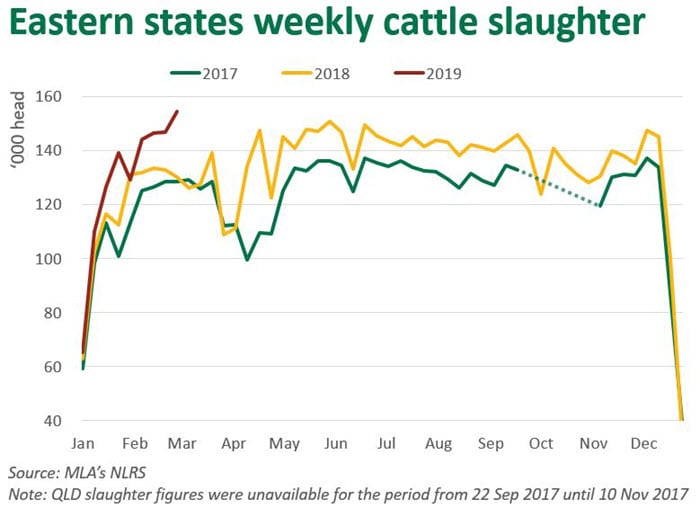Supply jump tips cattle market
The cattle market retreated further this week as turn-off ramped up across NSW and Queensland.
Parts of northern Queensland received intense monsoonal rainfall during February, however, many areas received next to none, including south-east Queensland and north-east NSW. While producers have been dealing with a lack of pasture and high feed costs for many months, many now face severe shortages of stock water.
Recent supply indicators are reflective of the season, with slaughter numbers and weekly yardings rising to levels not seen since the last drought-induced turn-off phase in 2015.
The market appears to have reached somewhat of a tipping point, with prices in decline across most categories. Young cattle are struggling to find a home due to a lack of interest from feedlot buyers and restockers alike, while over-the-hooks indicators have also begun to fall.
Saleyard throughput
Supply has risen strongly among most categories, from poor-conditioned store cattle through to better quality feeder cattle. Market reports also suggest a lift in quality breeding stock presenting in saleyards, which perhaps represents the largest disappointment for many producers who managed to hold stock through such a prolonged dry period.
For the week ending 1 March, yardings in NSW, Victoria and Queensland rose by more than 10,000 head on the previous week to 70,000 head.
In NSW, numbers totalled 35,000 head, up 15% on the previous week and up 46% on the same week in 2018. Northern saleyards such as Casino, Armidale and Gunnedah have seen rising numbers over the last fortnight. Not included in this data was TRLX Tamworth’s prime sale on 4 March, which saw the largest volume in a number of years at 4,480 head.
Queensland saleyard throughput rose 23% week-on-week to 25,000 head, up 36% on the previous year. Numbers rose in all NLRS reported saleyards across the state, including Dalby (up 2,332 head to 8,349 head), Emerald (up 788 head to 4,000 head) and the Roma store sale (up 655 head to 7,924 head).
Victorian weekly yardings rose 18% to 11,000 head, up 4% year-on-year.
Slaughter
Eastern states cattle slaughter for the week ending 1 March rose 5% on the previous week to 154,000 head, up 19% year-on-year. This represents the highest level since October 2015.

Saleyard indicators
On 6 March, the Eastern Young Cattle Indicator fell to 407¢/kg carcase weight (cwt), down 30¢ week-on-week and down 155¢ year-on-year. Increased weaner supply and limited demand were responsible for the decline.
Feeder steers also fell, with many feedlots reportedly operating at near capacity. The eastern states feeder steer indicator averaged 242¢/kg live weight (lwt), the lowest level since April 2015.
The medium cow indicator fell 23¢ week-on-week to average 157¢/kg lwt, with abundant supply witnessed in yards from southern NSW to central Queensland. Tellingly, a larger proportion of cows are falling below the weight and condition specifications for this indicator and are trading at a significant discount on a ¢/kg basis.
Over-the-hooks indicators
Turning to over-the-hooks (OTH) prices, cow indicators weakened across the eastern states last week. The medium cow OTH indicator fell in Victoria (down 12¢ to 350¢/kg cwt), NSW (down 12¢ to 372¢/kg cwt) and QLD (down 34¢ to 380¢/kg cwt).
Steer and heifer categories were largely unchanged in NSW and Victoria, however, indicators in Queensland fell 15–22¢/kg cwt.
Want market reports and prices tailored to you?
Check out MLA’s interactive market information tool.



